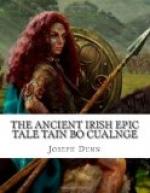It would seem from another note in the manuscript[10] that the Book of Leinster afterwards belonged to some admirer of King Dermod, for he wrote: “O Mary! Great was the deed that was done in Ireland this day, the kalends of August (1166)—Dermod, son of Donnoch macMurrogh, King of Leinster and of the (Dublin) Danes to be banished by the men of Ireland over the sea eastwards. Woe, woe is me, O Lord, what shall I do!"[11]
My reason for founding the translation on the LL. version, in spite of the fact that its composition is posterior by half a century to that of LU., was not merely out of respect for the injunction of the scribe of the ne varietur and to merit his blessing (page 369), but also because LL.’s is the oldest complete version of the Tain extant. Though as a rule (and as is easily discernible from a comparison of LU. and LL.), the shorter, terser and cruder the form of a tale is, the more primitive it is, yet it is not always the oldest preserved form of a work that represents the most ancient form of the story. Indeed, it is not at all improbable that LL. contains elements which represent a tradition antedating the composition of LU. At all events, LL. has these strong points in its favour, that, of all the versions, it is the most uniform and consistent, the most artistically arranged, the one with most colour and imagination, and the one which lends itself most readily to translation, both in itself and because of the convenient Irish text provided by Professor Windisch’s edition. In order to present the Tain in its completest form, however, I have adopted the novel plan of incorporating in the LL. account the translations of what are known as conflate readings. These, as a rule, I have taken from no manuscript that does not demonstrably go back to a twelfth or earlier century redaction. Some of these additions consist of but a single word: others extend over




